Raised by a Maker: Summer 2022 SDJ, Out Now!
July 18, 2022
Surface Design Association is excited to announce Raised by a Maker, our Summer 2022 edition of Surface Design Journal. This issue is filled with stories of those who have touched our lives in profound ways. Looking outside the traditional higher education and craft school systems of teaching, this edition continues to expand on what SDA defines as a teacher and student. From parents and mentors to lost crafts and families displaced by war, this Journal is just a sample of the traditions centered around skill-sharing. Yet these stories are so much more. Loop-by-loop, stitch-by-stitch and warp-by-weft, we have learned to build a tactile world, whether through family or community, which will shape generations of makers to come.
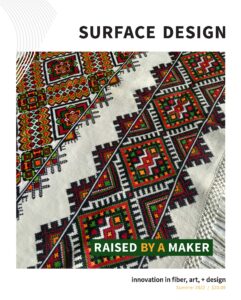
Here’s a preview of what you’ll discover:
“Interwoven Time: Saipua and the Farm at World’s End” by Ginger Knowlton: “The Farm at World’s End is home to artists, writers, gardeners and a flock of Icelandic sheep. Above all else, World’s End is a teaching farm, centered by mutual exchange of knowledge, various degrees of communal living, and the cycles of life and death. The Farm at World’s End embraces a model of education that honors multi-directional influence and interdisciplinary.”
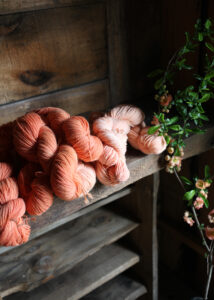
Madder-dyed, 2-ply Icelandic wool yarn, The Farm at World’s End, 2020. Photo: Sarah Ryhanen.
“A Funky-Chic Urban Aesthetic” by Paulette Young: “For Xenobia, the aesthetic of funk comes from the African American household, the way colors and motifs were used, how patterns were united, and textures fused together. It is inspired by African American homemakers’ crocheted doilies, afghans, tablecloths and bedspreads: the interior that is handmade.”
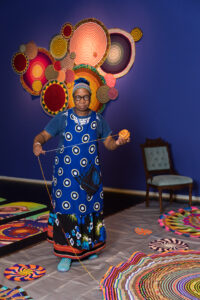
Xenobia Bailey, Studio Views, Craft in the Expanded Field (installation with artist), 2017. Courtesy of the Museum of Arts and Design. Photo: Jenna Bascom.
“Raised by a Maker: Irma Sofia Poeter” by Julia Dixon Evans: “As an artist, Poeter is loyal to this magic by using recycled, reclaimed fabrics and materials—some mundane, some full of history and strife, others adorned with shimmering sequins or spun with fine thread.”
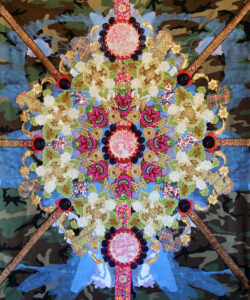
Irma Sofia Poeter, The Place Where the Past and the Future Meet, 2017. Appliquéd and embroidered digital photograph on canvas, 24 x 48 inches. Image courtesy of the artist.
“Exposing History: Color, Taste, and Textiles” by Nikki Fragala Barnes: “Mongiovi rejoices in complexities and constraints, especially when the tensions of a site-sensitive project generate insight and restoration of the presences—the fibers—of people and their technologies… Mongiovi is in conversation with structures and spaces as her work responds to centuries of domestic living.”
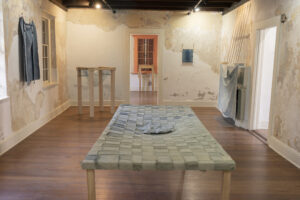
Laura Mongiovi, Indigo Room (installation), 2021. Tovar House, Oldest House Complex, St. Augustine, Florida. Photo: Jason Schwab.
Future Tense 2022 Select Artists: Celebrating the creative work of student artists, designers, and makers, Future Tense 2022 offers a glimpse into the future of contemporary fibers by presenting the very best work being made by students in the field today. Of the 24 selected artists, the four award winners are featured in the summer’s Journal. Congratulations to Cynthia Evans, Karena “Kidd” Graves, Savannah O’Leary, Emily Zarse and the other 21 exhibiting artists!
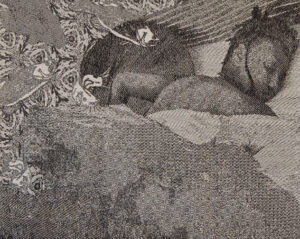
Karena “Kidd” Graves (she/him/they), Dreaming of Fish, 2022. 10/2 Cotton, Photoshop composition woven on TC2 Jacquard Loom, 32 x 40 inches. Photo: Robin Haller. Right: detail. @kiddkreates
In The Studio: “What’s on Your Needles, Son?” by Jonathan Kirkendall: “The week before this past Christmas, I visited [my mom] in Oklahoma City, in a rehab center where she had been placed after falling and breaking her pelvis, and once again came the familiar question: ‘What’s on your needles, son?’ I did my best to explain the Icelandic sweater I was working on and what mine looked like, in the simplicity of the knit stitch and complexity of the math and patterning.”
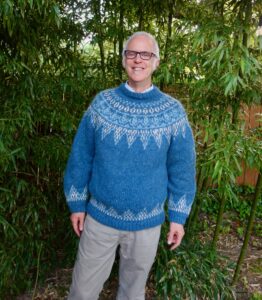
Eric pattern from “The Best of Lopi” by Susan Mills and Norah Gaughan, published 2002. Knit by Jonathan Kirkendall with Álafosslopi yarn, 2022.
In The Studio: “Raised By a Quilter” by Troy Murrah: “[My mom] had the biggest influence on my creative life… She was always asking me to incorporate quilts into my artwork. I couldn’t fathom how a quilt could come into the mix. ‘Sorry, mom, but I don’t think it could work… that’s your world of creativity, not mine.’ Now, years after I stepped away from visual art, I returned. I decided to finally make something based off a quilt, in her memory, as if to say, ‘See, mom? I did it.’”
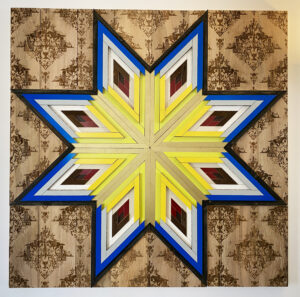
Troy Murrah, Cheetah Express, 2021. Mixed media, reclaimed materials, lone star quilt pattern, 53.25 x 53.25 inches. Photo by the artist.
In The Studio: “Flora Fauna Family” by Angelina Martin: “The healing attributes of garments worn by women provide strength and purpose on a spiritual and alchemic plane for those with the intent of caring for their community. This nurturing servitude to help others starts at the family level. For me this includes paying it forward by creating art with my sons, who contribute by modeling for measurements or wearing my ensembles on the runway.”
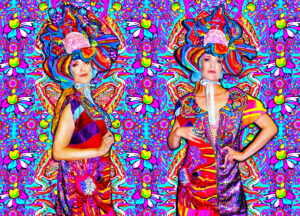
Angelina Martin, Passionflower Blooms in Cranes Apple Garden, 2021. Wood reed, coconut bark, copper wire, cloth, acrylic paint, painted, embroidered, beaded, coil basketry, headpiece: 18 x 22 x 12 inches, pinafore dress: 48 x 24 x 4 inches, background print: 84 x 64 inches. Photo: Angelina Martin.
In Conversation: “José Picayo: An Indirect Transfer of Knowledge” by Nomi Kleinman: “I first met Ethel about 25 years ago, through her daughter-in- law. Ethel showed me her studio and the loom. I didn’t think much about it other than I didn’t understand it and didn’t really have an interest in weaving. I was young and at the top of my career in photography. I was like, ‘What is that thing anyway?’ I didn’t see her again until after I started weaving, when I asked her son to take me to visit her.”
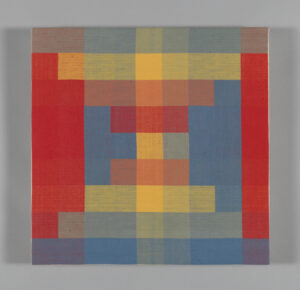
Ethel Stein, Red, Yellow, Blue, Green, Orange II, 1995. Cotton, satin damask weave, woven on a loom with a handmade drawloom attachment, 16 x 16 inches. Photo: The Art Institute of Chicago / Art Resource, NY.40.6 × 40.6 × 1.6 cm (16 × 16 × 5/8 in.). Gift of Ethel Stein (
2012.429).
First Person: “Raised by a Maker” by Adrienne Rogers: “My Ukrainian grandmother learned to embroider from her mother, and she, from her mother. My grandmother considered this traditional art form as vital women’s work. We didn’t speak the same language, yet my grandmother’s textiles offered valuable insight into who she was and where she came from.”
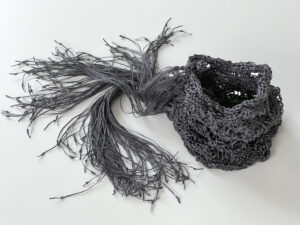
Adrienne Rogers, Linen Vessel, 2022. Handknit Japanese linen tape, 5 x 5 x 4 inches. Schweinfurth Art Center, Auburn, New York.
First Person: “Jugaad: About a Culture Of Looms” by Nishra Ranpura: “Jugaad is a term originally coined in India, which means ‘a flexible approach to problem-solving that uses limited resources in an innovative way’ (according to the Oxford languages definition). In most parts of India, jugaad is a house-hold term: a slang, a compliment for smart work, and also a snide comment for lazy work, but above all—at its core—it promotes frugal innovation.”
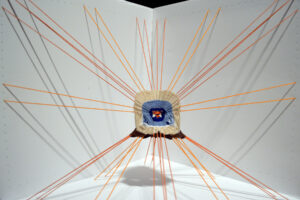
3D Loom, 2022. Foam board and tape, 14 x 14 x 14 inches. Photo: Nishra Ranpura.
First Person: “Maazi-e Hunarmand (The Forgotten Heroes)” by Sadia Kausar: “The motifs the Jacquard cards help create are specific patterns for him to meticulously weave using supplementary wefts. Jamdani, as we say in Urdu, is a skill that Altaf Baba has honed for over decades. It requires the careful precision of weaving each weft thread as different parts of the warp are lifted, all amalgamating into a cohesive design.”
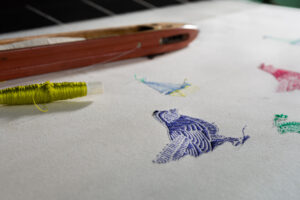
Altaf Baba, Jamdani technique in process, 2022. Pure fine cotton warp, colorful cotton supplementary wefts. Photo: Mahmood Ali Ahmed.
In Print: This Long Thread” reviewed by Astrid Hilger Bennett: “It is difficult to capture the essence of all the profiles in so few words; the book content is rich and varied. However, several themes emerge multiple times: the importance of family influences; the undeserved lower status of crochet versus knitting; robust discussions of hobby versus profession; and the difficulties of making a living through craft, both financially and for its toll on the body.”
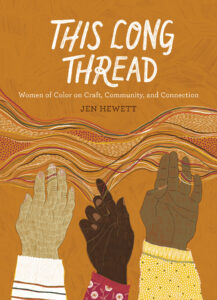
This Long Thread: Women of Color on Craft, Community, and Connection by Jen Hewett.
In Review: “Marilyn Pappas: A Retrospective” reviewed by Caroline Kipp: “At first glance, Pappas’ career seems to be dominated by two major bodies of work… It’s only upon touring through the gallery, and looking closer, that we begin to understand Pappas’ practice was uninterrupted during the intervening decades, developing quietly through her continued engagement with assemblage.”
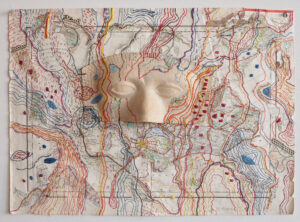
Marilyn Pappas, Maps and Masks: L’Europe, 2012. Mask, antiquarian map, thread, 14 x 18 x 1 inches. Photo: Ashley McDowell.
In Review: “Sheila Hicks: Off Grid” reviewed by Janis Jefferies: “Drawing together more than 70 works from public and private collections, Off Grid spans Hicks’ career from her earliest works made in the 1950s to new site-specific indoor and outdoor commissions… What is most striking is how Hicks’ sculptures radiate chromatic energy with gorgeous bulks of yarn and cotton thread, fashioned into exuberant cascades of linen and tasseled edges.”
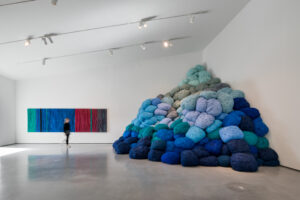
Sheila Hicks: Off Grid (installation), 2022. The Hepworth Wakefield. Photos: Tom Bird.
To buy a copy of Raised by a Maker, go to the SDA Marketplace, or you can check out a free digital sample on our SDA Journal page.


